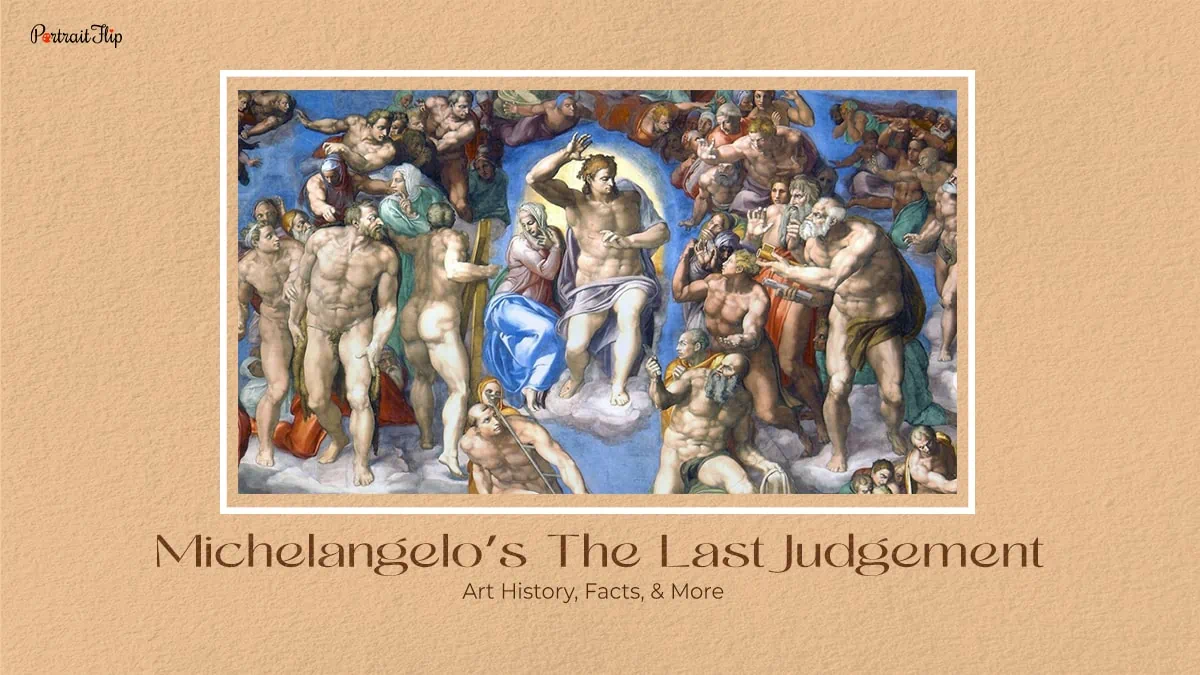This is the story of the year 1508.
The popes tasked a well-known artist to adorn the ceiling of the most famous place in Vatican City—Sistine Chapel.
Now that I’ve mentioned the Sistine Chapel, can you guess the name of the artist?
Who else other than the great Michelangelo?
When you visit the Sistine Chapel, you’ll see the paintings by Michelangelo all over the place.
His frescoes narrate epic tales from the Old Testament.
But my eyes fell on this single piece of art that blew my mind with its detailing and massive work.
It captured my screen and my mind.
That amazing piece was Michelangelo’s The Last Judgement, which took my breath away.
The large, alluring fresco on the walls of the Sistine Chapel tells a whole different story about the place.
Definitely a masterpiece!
But why is it called “last judgement?” Whose last judgement is the artist depicting? What is that final judgement?
Well, with this thought, I’ve covered this popular work of art to give my readers an interesting piece.
I know you are all curious to learn the backstory of this spectacular piece.
Table of contents
The Man Behind the Art

The painter of the famous artwork “Creation of Adam,” the man who left his marks on the walls of the Sistine Chapel for eternity, the artist who influenced and stunned many people with his skillful hands.
We are talking about Mr. Michelangelo di Lodovico Buonarroti Simoni.
Yes, that is his full name.
Michelangelo was a famous Italian artist and an admirer of art who would imitate paintings in churches with his remarkable brushes
After Leonardo da Vinci, it was Michelangelo who left his prints with exceptional pieces.
He was also a well-known sculptor and architect.
You can witness his two famous sculptures in the image below.
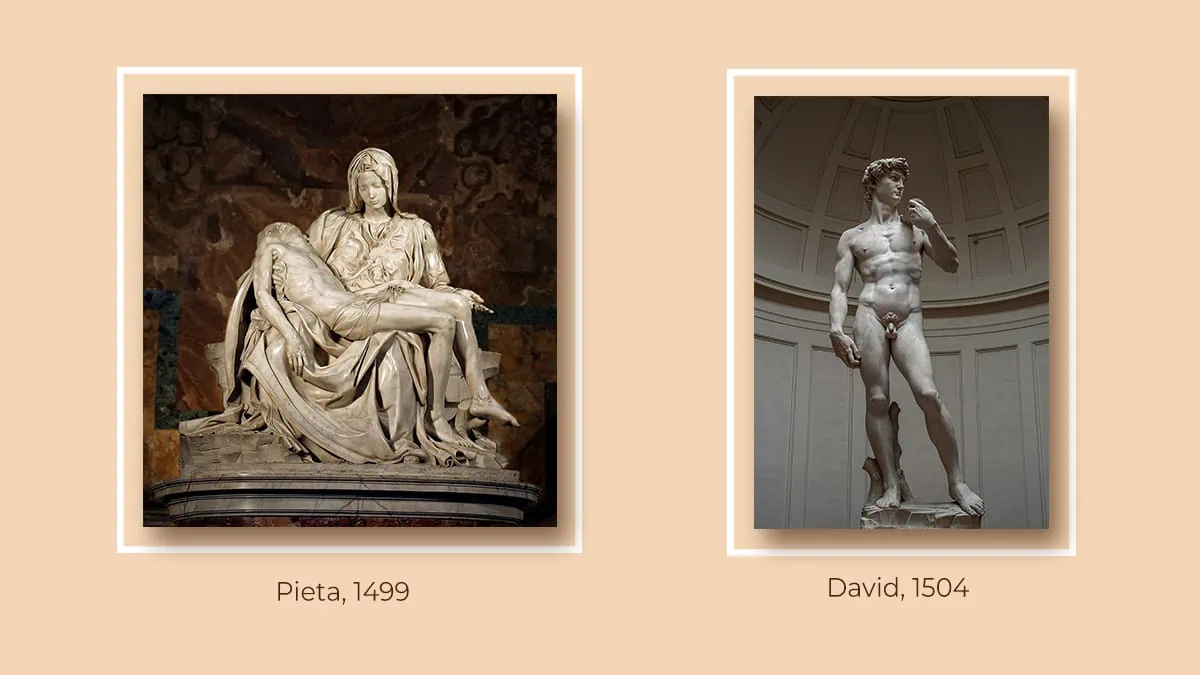
And in 1541, Michelangelo made the most recognized art of Sistine Chapel—The Last Judgement painting.
The story began when Michelangelo had just completed his fresco work in the Sistine Chapel.
Little did he know that his next masterpiece was waiting for him.
He was asked to produce another fresco for the place and this time it was on the altar wall.
Therefore, the Last Judgement painting happened!
It was the most important location of the place.
The area was considered the highest altar of the Sistine Chapel.
This is where the pope led mass and on today’s date, it is still the room where the selection of the next pope is made.
But there is another reason why this large fresco became insanely popular.
Keep reading to know all the secrets!
The Last Judgement Painting Analysis
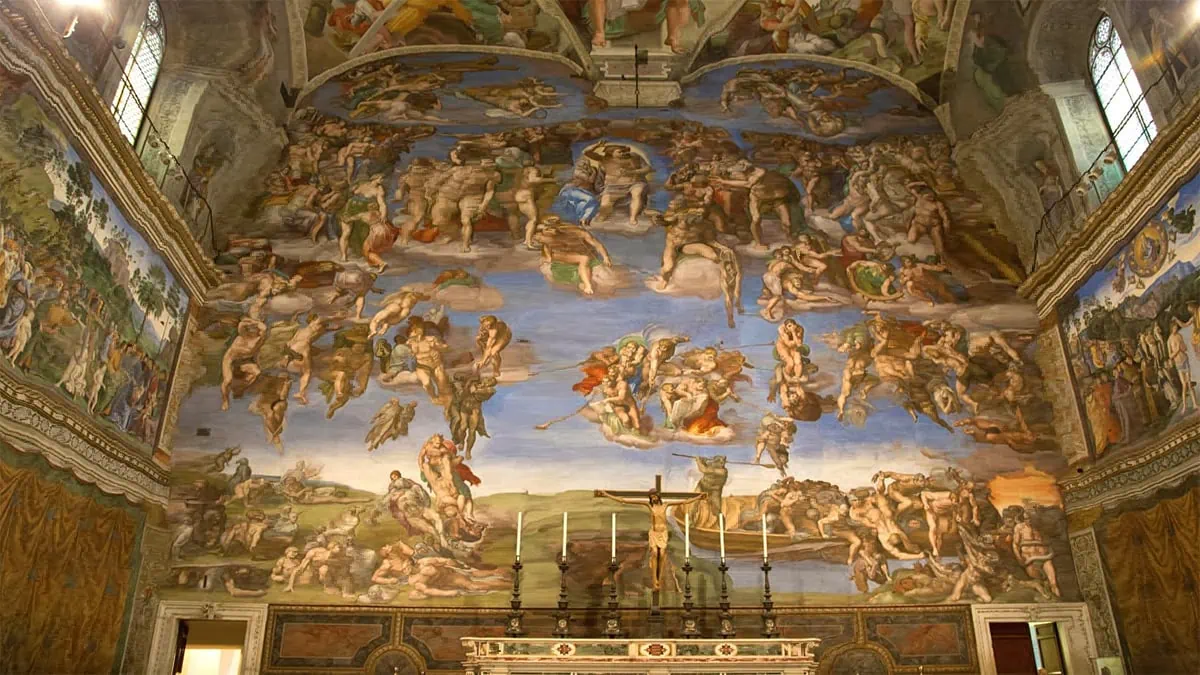
| Created In | 1536–1541 |
| Medium | Fresco Artwork |
| Period | High Renaissance |
| Series/Versions | Part of Sistine Chapel Fresco |
| Housed in | Sistine Chapel, Vatican City, Rome, Italy |
| Worth | Estimated value of $540 million |
| Dimensions | 13.7 m x 12 m |
300 or so nude figures that bring an awe-struck feeling to the audience is what The Last Judgement creates.
Doomsday, Day of Resurrection, Day of Reckoning, or the Day of the Lord—do you recognize these words?
It captured my screen when I was searching for fresco artwork.
Let me tell you that they are not the names of separate artworks.
Instead, Michelangelo The Last Judgement is also known by these names.
You know why?
This is because of the representation of the art and its secret meanings.
Well, the painting narrates the second coming of Christ and the final and eternal judgement of God over all humanity.
If you notice, the artwork is divided into two realms.
The upper part depicts the heavenly world above, contrasted with the intense view of the earth below.
You can say that all forms of humanity have been brought to light through Michelangelo The Last Judgement.
The Renaissance Pope asked Michelangelo to paint about the creation of the world and humanity.
Paul asked for a painting that portrays judgement, endings, and the consequences of sin.
We all know what happened after that.
Michelangelo painted The Last Judgement.
Let me share some interesting facts with you all that will blow your mind.
5 Mysterious Facts About the Last Judgement
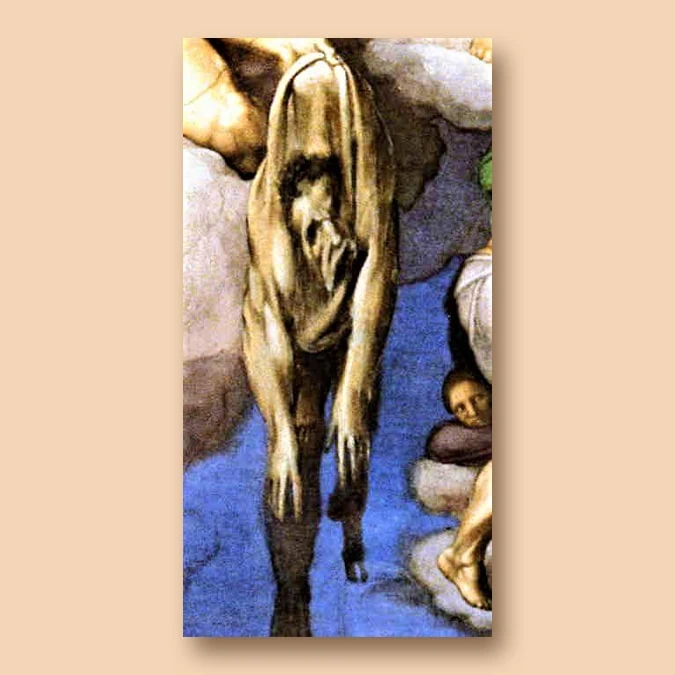
- It is believed that the piece is also a self-portrait of Michelangelo. The peeled skin in the painting resembles his face, which you can observe from the image on your left.
- In comparison to The Last Supper by Leonardo da Vinci, Michelangelo The Last Judgement was said to be a massive work measuring 39 feet by 45 feet.
- Due to the revealing view in the painting, it was said that prior to Michelangelo’s death, the councils engaged artist Daniele da Volterra to add clothes to the naked figures.
- Approximately 25,000 people per day take in the view of The Last Judgement in the Sistine Chapel.
- The golden ring surrounding Christ and Mary in the center can be a representation of the Greek god of sun, Apollo.
You can also read Michelangelo’s facts, which will intrigue you with his life history.
Story Narration From Sistine Ceiling (Art Perspective)

Another narration of the Sistine Ceiling about the art?
Hell yes!
Don’t you want to know why Sistine Chapel? Why the altar wall only and not some other place in the chapel?
While researching, these were the biggest questions on my mind.
To answer the question of why the art was made in the Sistine Chapel, it was because of Pope Clement VII.
He commissioned Michelangelo The Last Judgement.
Another reason why the Sistine Chapel was painted is that the Sack of Rome in 1527 created destruction in Italy.
Especially the damage to the Papacy Foundation.
The attacks were against the Catholic Church and the Papacy.
In 1517, Martin Luther published Ninety-Five Theses (known as the Protest).
If I start mentioning what happened, then it may need a separate blog.
In a nutshell, due to the above-mentioned events, the Pope needed to strengthen their reputation and rebuild themselves.
That is the reason they thought of giving the place a makeover.
Now the question about why the altar wall got painted is because of the people.
When people visit the place, they come face-to-face with the painting and are unable to avoid the narrative of Christ’s second coming.
They will get an idea about the hell and torture scenes as well as humanity.
The Popes wanted to communicate with the people with the help of The Last Judgement.
This served the purpose of ensuring that when people leave the church, they will go with a final message.
Paintings with mysteries and intriguing stories surely need a beautiful wall to describe them.
Here is your chance to bring this fresco from Sistine to your walls.
You can now own a Michelangelo masterpiece with just one click.
Overview of Over 300 Character
When we take a glance at the massive Sistine fresco, we enter a space filled with over 300 figures with powerful poses and expressions.
A perfect proportion in art depicts hundreds of humans.
But when you look carefully, you’ll notice that the painting is divided into small groups.
Each figure has a separate stand in the Last Judgement fresco.
Below, you’ll find the perfect elaboration of the characters present in the painting.
Bottom Left of Michelangelo The Last Judgement
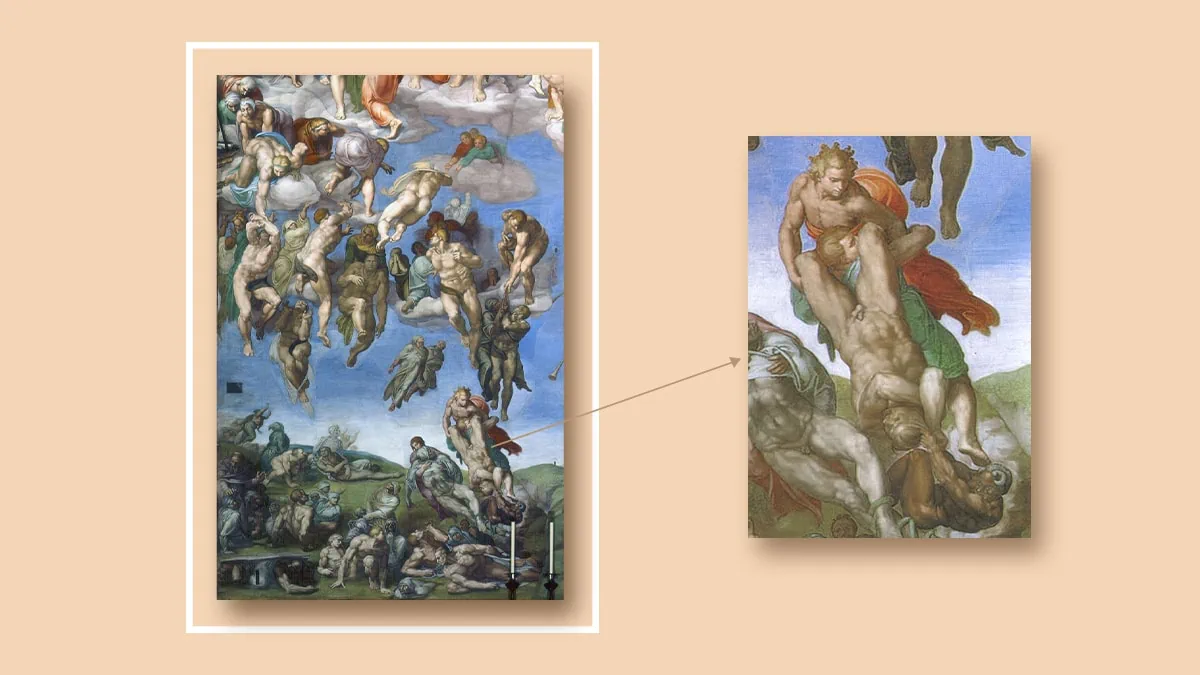
If you observe the bottom left corner of the painting, you’ll see a successive flow where people are moving towards heaven.
Some are either assisted by angels or are flowing themselves in an upward direction.
What I assume while going through this side of art is that it shows people who are going to heaven rising straight after they were buried.
One unusual thing that I noticed was the figure in the right corner of the above image.
You’ll see that a figure is under the grip of an angel as well as a demon.
He is pulled with equal force in both directions.
Well, the bottom right corner of the painting contrasts with the left side.
Bottom Right of Michelangelo The Last Judgement
In the bottom right, we observe the people who are on their way to hell.
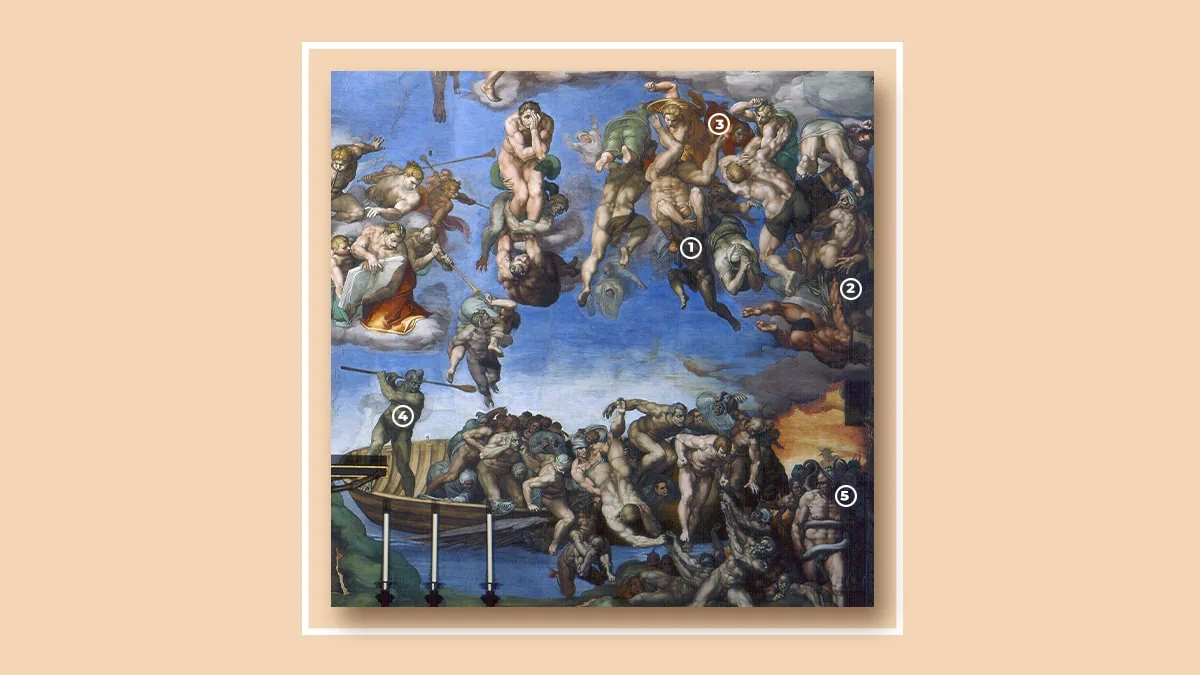
This corner of the painting is filled with abusive souls who have committed various sins.
- The figure with a money bag and a key hanging from his neck depicts the sin of greed.
- One figure is pulled by his testicles, which symbolizes the sin of lust.
- Another figure is fighting the process, which represents pride.
- You can also notice a notable figure from hell, Charon. He derives from Greek mythology and is known as “Ferryman,” who transports souls to the hellish shores.
- The figures meet Minos (a judge for the people entering hell) with donkey ears and a serpent wrapped around his body.
The view is nasty and dreadful for the audience as it unravels the reality of hell.
Center of Michelangelo The Last Judgement
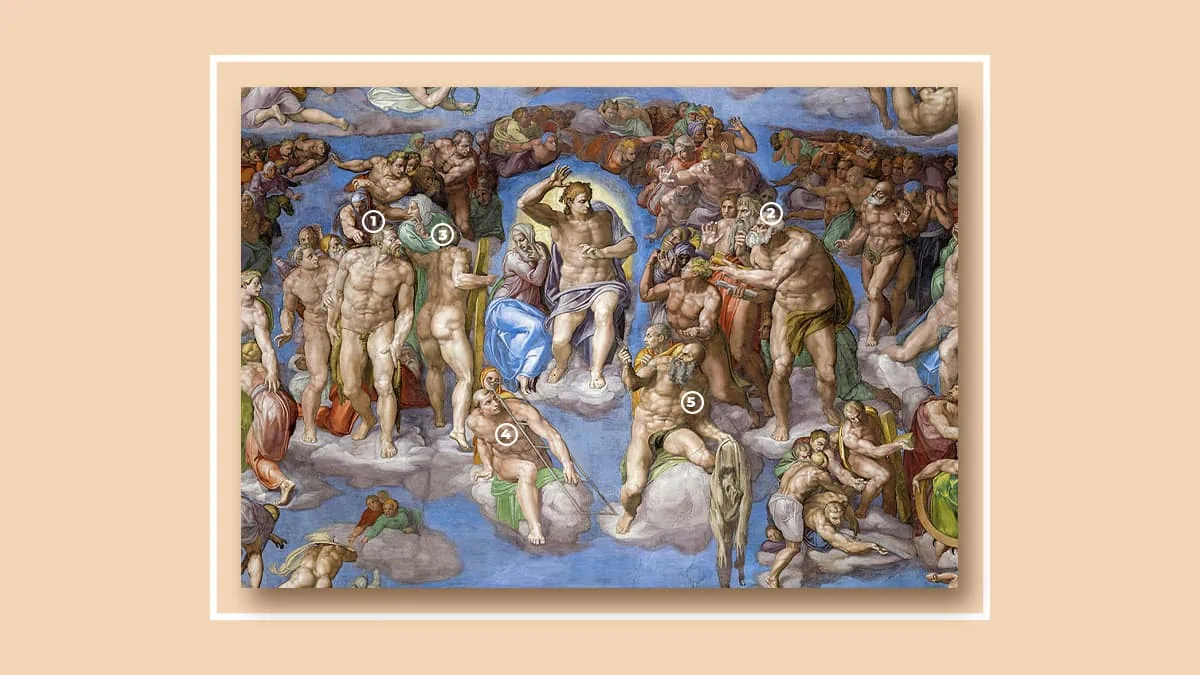
We see Christ in the middle, along with Mother Mary to his right (our left).
Jesus is surrounded by various angels, saints, and martyrs, bringing a good amount of texture in art.
1. Do you see a figure to Christ’s right (our left) holding a camel pelt behind his back, covering his genitals?
That is St. John the Baptist.
2. Again, if you see to your right (Christ’s left), there is a man holding keys.
He is Saint Peter, who has keys to heaven.
But we see him in a position where he seems to handle the keys back to Christ.
This means that his role as the keeper now comes to an end.
3. There are other notable figures, such as St. Andrew holding a cross next to Christ with his back to the audience.
4. You can also see Saint Lawrence with a large grate in his hand.
5. Do you notice a man holding a peeled skin in his hands and a knife? That is St. Bartholomew. Yes, the same skin bears a resemblance to Michelangelo’s face.
You can also observe the angels holding trumpets, which is a reference to the trumpet call explained in the books of the Bible (Book of Matthew).

Upper View of Michelangelo The Last Judgement
The higher view of the Last Judgement painting features two lunettes.
These represent Christ’s Passion, the Cross, Christ’s Crown of Thorns, and the Pillar.

We see that all the angels are wingless, which symbolizes Christ’s sacrifice and restoration to life.
I must say, what deep meaning does this large fresco have in itself?
No wonder it is counted as one of the best works by Michelangelo.
Explaining the Methods of Michelangelo
Don’t you want to use the methods that the great artist Michelangelo used in the painting?
What contributed to the art’s growth in the most prominent way?
Michelangelo’s Use of Metaphor
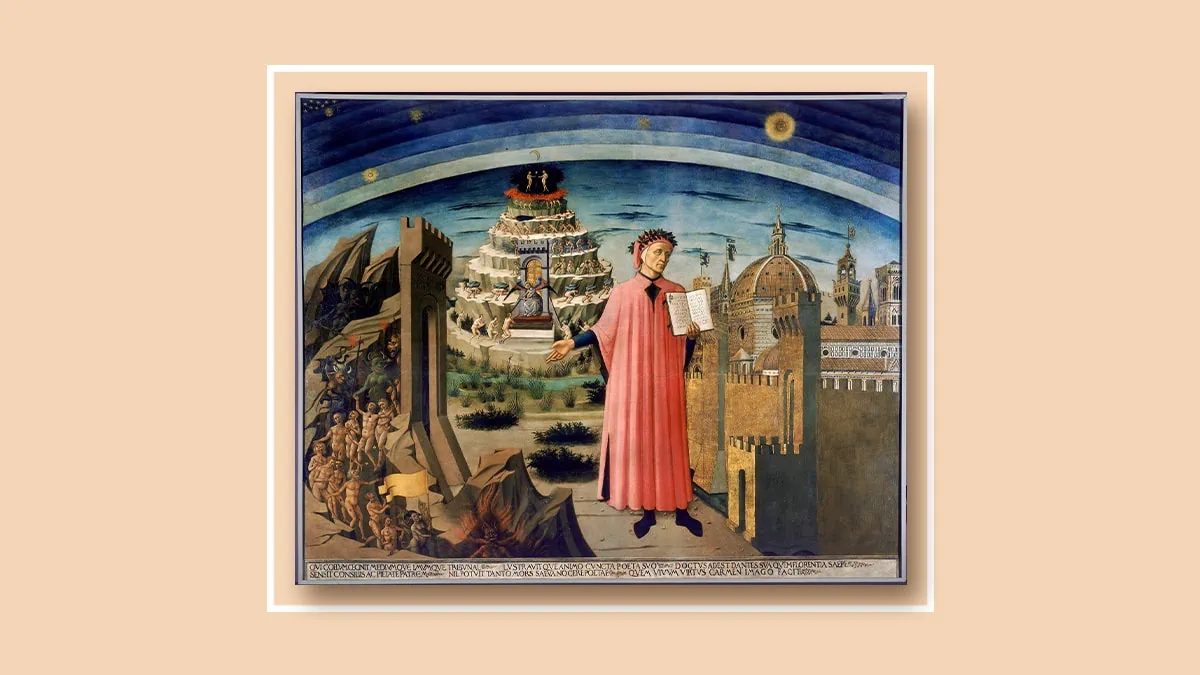
A metaphor?
I guess our skilled artist, Michelangelo, was into literature as well.
Jokes apart, he embraced many symbolic and metaphoric references in the painting.
Michelangelo made remarks about the Italian poet and writer Dante Alighieri.
He included several references to Dante’s poem “The Divine Comedy.”
The first part, Inferno, is said to be the symbolic representation in the art.
If you read the poem, it is divided into three parts: Inferno (hell), Purgatorio (purgatory) and Paradiso (paradise).
A quick question for you: where do you see the reference to Inferno (hell) in the painting?
Yes, that has to be the bottom right corner, which I have already explained in the above section.
If you remember, I explained two characters, which are Charon and Minos.
These two figures belong to Dante’s poem.
But why did Michelangelo use metaphors like these in the first place?
Well, he made sure that his audience understood the artwork as soon as they had a glance at the figures.
They would pick up the visual signals and metaphors.
What a genius!
Michelangelo’s Technique: Use of Color & Light

Blue sky, light skin tone figures, and contrast work in the bottom with grayer shades.
All I can observe are these features that highlight this representational art in a vast picture.
The fresco technique was the most commonly used and we all know that it was a commissioned artwork.
Especially the walls of the churches, which often seem to have large murals.
The light illuminates the top sections and as we go down, there is more shadow.
It all just fit the theme of the painting.
A 1541 Controversial Art: The Conclusion
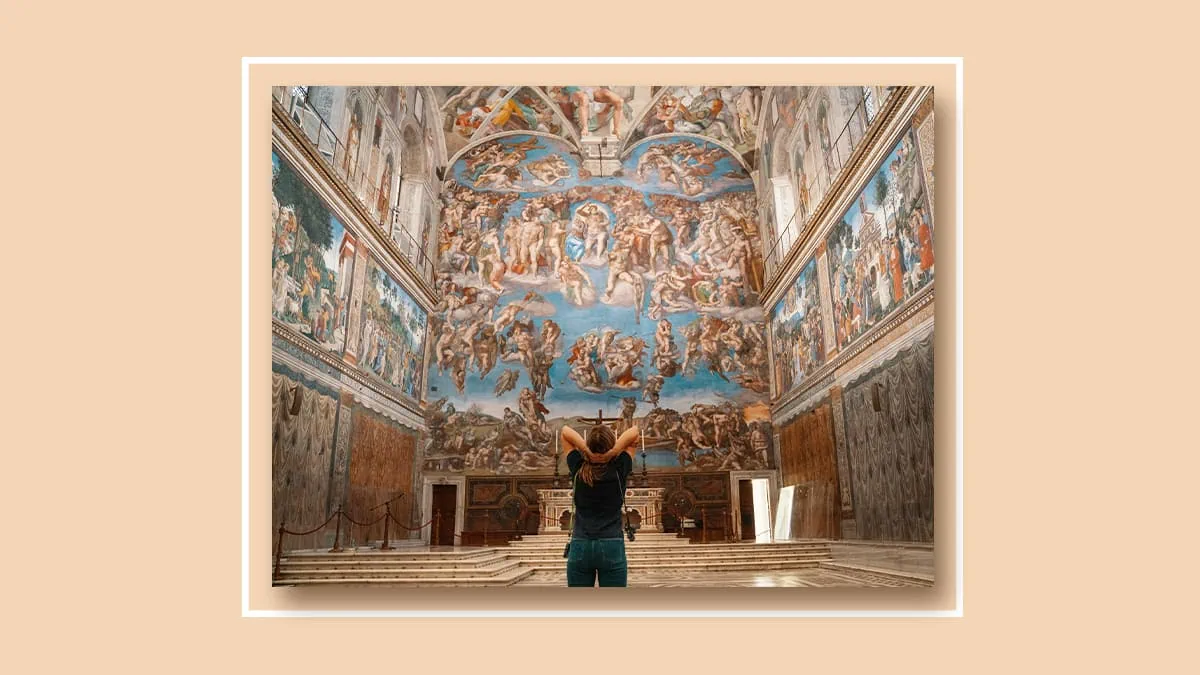
A painting depicting the harsh truth of humanity has to be controversial.
It’s no surprise that the art received a tremendous amount of attention and criticism.
It sparked much criticism and praise when it was disclosed in front of people in 1541.
The painting caught the attention of those in the Catholic Church who were still living with the feeling of Protestant Reformation.
People appreciated the skills of Michelangelo and the thoughts behind the art.
The Italian writer Giorgio Vasari mentioned in his publication, Lives of the Artists (1550), the opinion given by da Cesena.
Da Cesena said that it was a disgraceful thing to be made in such a holy place.
All the naked figures, along with a demolic view, show that it is not a work to be displayed in the chapel.
In response to this unkind comment, Michelangelo painted Da Cesena’s portrait as Minos’s character with a coiling snake around his body.
When da Cesena complained to the Pope, they told him that his power does not extend to hell.
Wow, what a reply!
I have mentioned just one story about how people found the artwork after their first glance.
There are n-numbers of controversies that were made against and even for the art.
You know the best part?
Regardless of such criticism, it is one of the best paintings of all time.
Suggested read: Salvator Mundi by Da Vinci
Ciao Readers
What an engrossing topic to share, right?
Were you captivated by the story and found what you were looking for?
You can put your point forward, along with any suggestions or questions, in the comments.
That place is open to all.
Imparting wisdom from one person to another is how we all grow.
This way, I’ll also learn some new things about art.
I’ll be back with my next piece super soon.
Till then, read, share, and explore. See ya!
FAQs
The painting represents the second coming of Christ and God’s final judgement for all humanity.
Michelangelo’s The Last Judgement gives the most powerful interpretation of history, with over 300 nude figures.
Baigio da Cesena criticized the work by mentioning that sacred places like the Sistine Chapel shouldn’t depict such bold images.
“The Divine Comedy” by Dante was the biggest inspiration, which can clearly witness through the characters like Charon and Minos in the bottom right corner.



